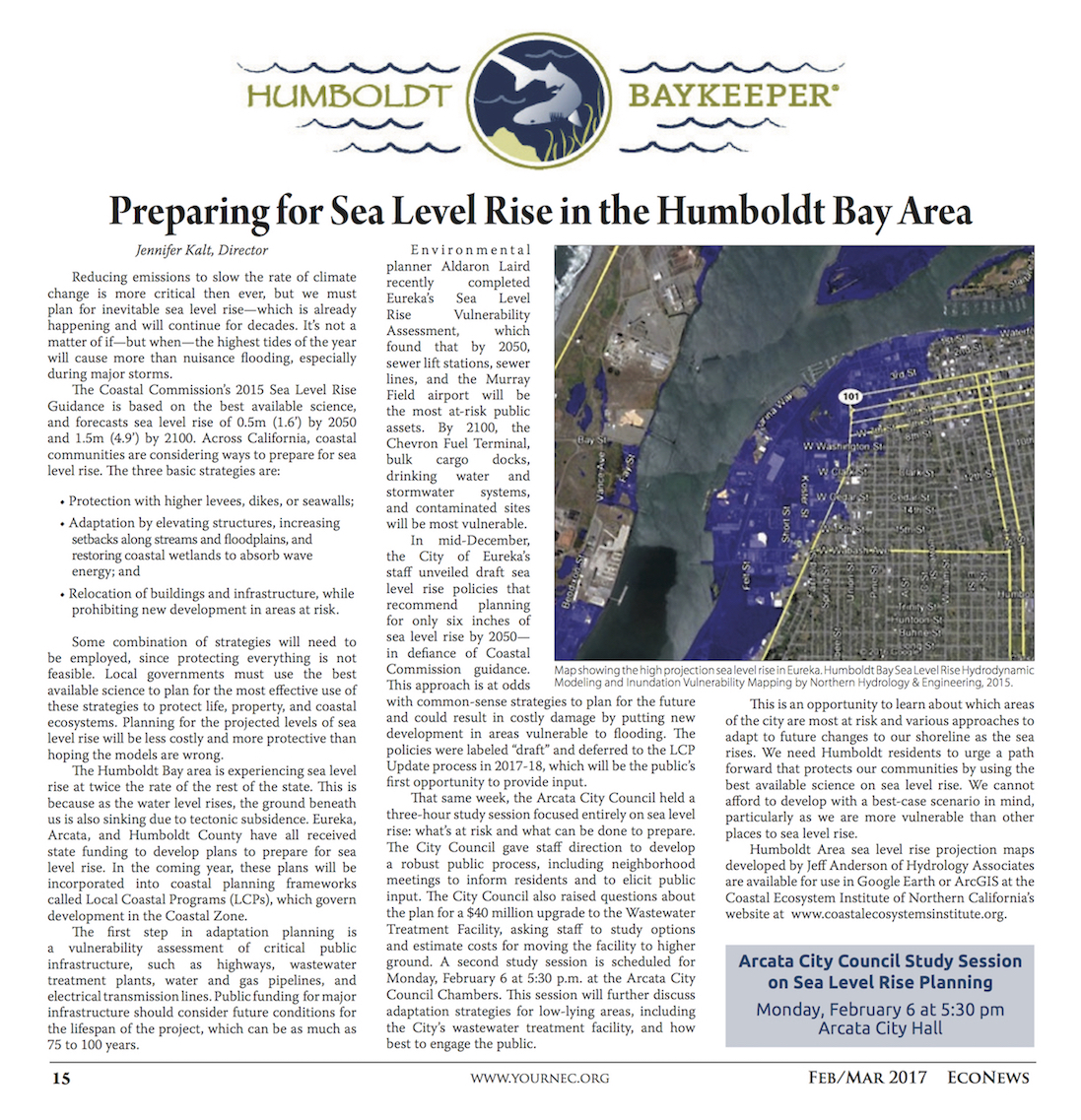Arcata and Eureka are beginning to prepare for sea level rise, and there will be opportunities for the public to weigh in throughout 2017. Reducing emissions to slow the rate of climate change is more critical then ever, but we must also plan for sea level rise, since the Humboldt Bay area is experiencing sea level rise at twice the rate of the rest of the state due to tectonic subsidence.
Reducing emissions to slow the rate of climate change is more critical then ever, but we must plan for inevitable sea level rise, which is already happening and will continue for decades. It’s not a matter of if—but when—the highest tides of the year will cause more than nuisance flooding, especially during major storms.
The Coastal Commission’s 2015 Sea Level Rise Guidance is based on the best available science, and forecasts sea level rise of 0.5m (1.6’) by 2050 and 1.5m (4.9’) by 2100. Across California, coastal communities are considering ways to prepare for sea level rise. The three basic strategies are:
- Protection with higher levees, dikes, or seawalls;
- Adaptation by elevating structures, increasing setbacks along streams and floodplains, and restoring coastal wetlands to absorb wave energy; and
- Relocation of buildings and infrastructure, while prohibiting new development in areas at risk.
Some combination of strategies will need to be employed, and local governments must use the best available science to plan for the most effective use of these strategies to protect life, property, and coastal ecosystems. Planning for projected sea level rise will be less costly and more protective than hoping for less.
The Humboldt Bay area is experiencing sea level rise at twice the rate of the rest of the state because the ground beneath us is sinking due to tectonic subsidence. Eureka, Arcata, and Humboldt County have all received state funding to develop plans to prepare for sea level rise. In the coming year, these plans will be incorporated into coastal planning frameworks called Local Coastal Programs (a.k.a. LCPs), which govern development in the Coastal Zone.
The first step in adaptation planning is a vulnerability assessment of critical public infrastructure, such as highways, wastewater treatment plants, water and gas pipelines, and electrical transmission lines. Capital expenditures for major infrastructure should consider future conditions for the lifespan of the project, which can be as much as 75 to 100 years.
Environmental planner Aldaron Laird recently completed Eureka’s Sea Level Rise Vulnerability Assessment, which found that by 2050, sewer lift stations, sewer lines, and the Murray Field airport will be the most at-risk public assets. By 2100, the Chevron Fuel Terminal, bulk cargo docks, drinking water and stormwater systems, and contaminated sites will be most vulnerable.
In mid-December, the City of Eureka brought forth sea level rise policies that recommended planning for only 6 inches of sea level rise by 2050 in defiance of Coastal Commission guidance. These policies could result in costly damage by putting new development in areas vulnerable to flooding. This approach is at odds with common-sense strategies to plan for the future. The policies were labeled “draft” and deferred to the LCP Update process in 2017-18, which will be the public’s first opportunity to provide input.
That same week, the Arcata City Council held a 3-hour study session focused entirely on sea level rise: what’s at risk and what can be done to prepare. The City Council gave staff direction to develop a robust public process, including neighborhood meetings to inform residents and to elicit public input. The City Council also raised questions about the plan for a $40 million upgrade to the Wastewater Treatment Facility, asking staff to study options and estimate costs for moving the facility to higher ground. A second study session is scheduled for Monday, February 6 at 5:30 pm at the Arcata City Council Chambers. This session will further discuss adaptation strategies for low-lying areas, including the City’s wastewater treatment facility, and how best to engage the public.
This is an opportunity to learn about which areas of the city are most at risk and various approaches to adapt to future changes to our shoreline as the sea rises. We need Humboldt residents to urge a path forward that protects our communities by using the best available science on sea level rise. We cannot afford to develop with a best-case scenario in mind, particularly as we are more vulnerable than other places to sea level rise.



